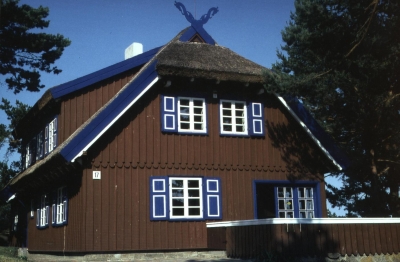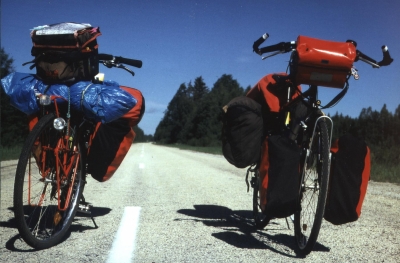
Broad plains & rolling hills
The last day of May 2000 my friend Georg and I started our tour. We caught the train from Speyer to the isle of Rügen with our bikes in the bike compartment. Then we took the ferry to Klaipeda in Lithuania. Broad plains, rolling hills, dense forests with marshland, many rivers and lakes: these are the main features of Lithuania, waiting for us to explore. Our journey lead us to the border to Latvia via Kretinga through the Zemaitijos-National-Park. In Salantai we received from the vicar the keys of an empty house situated next to the church. As we were hungry, we entered a little pub which was hardly recognizable from the outside. For the first time we got to know the very nice local cuisine. As the menu was written in Lithuanian and the landlord didn't speak any other languages, this was our first culinary adventure - the potato-dumplings with meat stuffing tasted nice. Afterwards the landlord arrived with another dish which was "on the house". With the meal we had a delicious Lithuanian beer. Contented we looked forward to the next days to come. The next day we crossed the border to Latvia at Ezere. Crossing the border did not present any problems as there is no need anymore for a visa. We intended to go to Saldus as we were invited by a Latvian organisation called "EVA". The aim of this organisation is to maintain the Latvian heritage and to promote various talents in the countryside.Rural meetings
Of the 65,000 km² surface of Latvia about 39 % is covered by forest. Besides there are over 3,000 lakes and 12,000 waterways. Our journey to Saldus gave us a first impression of the beauty of Latvia's landscape: many forests, numerous waterways and occasional little lakes. Furthermore, the country is sparsely populated (38 inhabitants per km² / Germany: 228 inhabitants per km²) and there is very little traffic in the countryside. After a ride of 120 km we reached Saldus where Ms Aija Maurina, the manager of the organisation "EVA", greeted us heartily. She spoke German very well and we were allowed to stay at her small but nicely furnished flat for the next two days. During this time we learned a lot about the history and the culture of this country.
Traditional Latvian Dances

Crossways through Latvia towards the North
While strolling through the streets of Riga, one understands straight away why this city used to be called "Paris of the north" in the Thirties. The grand architecture with examples of all styles from the Middle Ages to the Modern times is the reason why Riga is listed as a world heritage city by UNESCO. Splendid buildings from the Middle Ages to the time of the Art Nouveau style, old town walls and churches characterize the old town (Vecriga). The next day we continued on the motorway (!) to Riga and through the centre towards the Gauja-National-Park.The river Gauja flows with numerous bends through virgin forests and during many centuries it has carved itself deep into the stone. It is surrounded by up to 30 m high reddish-brown and golden-yellow sandstone cliffs with caves, grottoes and gorges. Before reaching the medieval town of Sigulda we had to pass the remaking of a kilometre of road. As it was blocked for car traffic, we could continue our way peacefully. Sigulda is situated in the region of Vidzeme. Many castles, old wooden houses and nature are the main attractions of this area. The next day we explored the castle Turaida, a former stronghold of the Livonians, and the surroundings of Sigulda by bike and on foot. We spent the night in a new guesthouse. The landlord passed in his car to check how we were. Then he left but an hour later - it was nearly 10 pm - he came back and gave me a music tape about which I questioned him before.
In the evening we had a beer and a long chat with the receptionist. The Latvian beer was excellent too. The next morning before leaving, we invited her to have breakfast with us. This has never happened to her before. She could hardly believe it and found it:" Very, very interesting."
Behind Valmiera our journey continued in the direction of the border to Estonia. There were quite a few mosquitoes at our camping site at the river Gauja near Strenci but there were also two beavers building a dam in the river. The only sound breaking the serenity of the night came from the sawmill opposite.
Estonia - broad and open-minded
Near Valka we crossed the border to Estonia. There were hardly any road signs. Estonia has about 1,5 million inhabitants. 450,000 live in the capital Tallinn. Estonia also has dense forests and many open fields. There are not many hills but in return many moraines and far reaching moors as well as extended sandy beaches in many parts of the country. This vastness which we have felt and experienced for a few days had a calming effect on us and besides made us feel a new form of open-mindedness towards the people there and viceversa. We stopped at a house in the countryside to ask if we could put up our tent there. The man spoke English and also some German. So we were even allowed to chose by ourselves the camping place on this huge property. Two hours later we were invited for dinner.We continued our ride along meadows and very long birch forests via Jegova towards Tallinn. Our camp for the night was a farm near the forest. This time we didn't have to put up our tent because we were offered the room of one of the sons. Despite language difficulties we got on very well. Everything there was simple and modest but the hospitality was warm and genuine. Before going to bed we had a little stroll in the nearby forest. To our surprise we got the chance to observe from close a fine specimen of a beaver in a little waterway. An unforgettable event !

Wood art
As we reached the outskirts of Tallinn we felt a strong wind blowing in our face. We spent the night in a hostel near the old town. We were the only guests. To our delight we could put our bikes in the hallway. Tallinn consists of an undamaged, medieval town centre, surrounded by buildings from the Russian times. The Raekoja plats (Town Hall Square) with the medieval Town Hall (built 1371-1404) form the heart of the city. This medieval city still is surrounded by the town walls and it contains many historic treasures.

One of the countless lakes in the Baltic Region
Once more towards the East
Georg had to take the ferry from Tallinn to Rostock and from there back home whereas I still had another week left. At first I caught the train from Tallinn to Valga via Tartu to the Estonian-Latvian border. It was not very easy to find the correct way to Latvia without proper road signs. After a rest in Smiltene ("Town of three hills") and a ride through unimportant villages and towns, I asked in a little hamlet if I could put up my tent behind the house. I got permission but as I had just finished putting it up I was called into the house. Here the daughter told me in very good English that the family had only come here for visit and that before the grandmother used to live in this house. As the family had to go back home now, they allowed me to spend the night in the house. They gave me the door keys which I should put behind the toilet after leaving the house the next morning.On my way through Latvia I saw storks everywhere. They looked for food only a few metres away from the road without being disturbed. Jékabpils was the last bigger village before I got to the border to Lithuania. After having done some shopping in a little shop, a family spontaneously invited me to their house for high-tea. This time it was a Russian family. The language spoken in the area I was crossing was only Russian. The daughter still attended school and spoke English quite well. This enabled us to communicate. After this unexpected tea I continued my way in the evening to a little farm - dusk only begins at 11 pm. Near a stork nest (with young) I put up my tent. Although the people did not understand any English or German and I could only say a few words in Latvian, they brought me a plate with food. Simple cuisine, but it came from their heart.
Via the centre of Europe to Vilnius
I was challenged by a 23 km long chalk and gravelled road before I crossed the border at Subate to Lithuania. Once again there were hardly any road signs. To my surprise the topography started to get quite hilly and the wind started to blow too. I made a break at a lake with wonderful yellow blooming water lilies. I offered some nuts to two passing locals. Shortly afterwards they invited me to stay the night. But as it was very early I politely refused and continued. Just a few kilometres further along I noticed some deer in the meadows. After another night near a property I cycled via Utena and Molétai to Vilnius, the capital of Lithuania. Just before getting there I crossed the geographical centre of Europe which is - to many peoples surprise - in Lithuania.
Water castle of Trakai
The next day I made a little excursion to the water castle of Trakai which lays in a picturesque area at the Galve lake. It can only be reached over a little footbridge. It was built in the 14th century as a residence of the grand dukes of Lithuania and as a bastion against the Crusaders. Today it is a Museum of History. In Trakai there lived and still live so called Crimean Tartares who once were deported to here from the Crimea. On a cycling tour through Ukrania to the peninsula of Crimea I met this population before.
Klaipeda and the Baltic Lagoon
The journey by train from Vilnius to Klaipeda was a very special adventure. As the conductress was very hesitant, it was very difficult to get the bike into the train. At last, after much debate, it was put vertically into the service compartment which was then locked. Now the 5 hour trip could begin.Late in the evening I reached the harbour town Klaipeda, which was point of departure as well as destination of my tour. I spent the night in a youth hostel which I could only find after a long search in a narrow side street. The next day, before returning to Germany by ferry, I took a bike ride along the Baltic Lagoon. Besides the biggest dunes of Europe ("Lithuanian Sahara"), cranes and colonies of cormorants there are also little villages like Nida with the Thomas-Mann-Museum. These villages were once founded by German settlers. The road coiled lightly up-hill through a landscape of heather and various deciduous and coniferous forests. Sometimes it also allowed a beautiful view on the Baltic Lagoon and the Baltic Sea. A nice bath in the sea at an endless beach made a grand finish to a marvellous day.

The famous Thomas-Mann-Museum in Nida in the Baltic Lagoon
